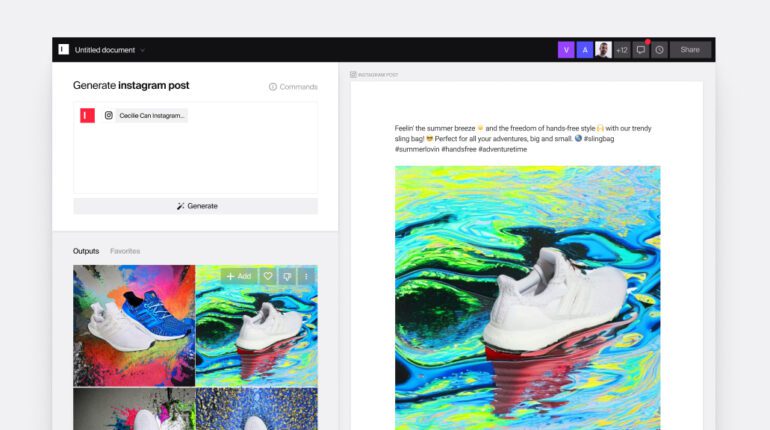TL;DR:
- Typeface, the platform for AI-driven content creation, has raised $100 million in a Series B funding round, led by Salesforce Ventures.
- The funding brings Typeface’s total raised capital to $165 million, following partnerships with Google Cloud and Salesforce to enhance AI accessibility.
- Companies can leverage Typeface to generate personalized images and text using their own data and licensed AI models.
- The platform has a diverse customer base ranging from small to large businesses across various industries worldwide.
- Typeface’s innovative features, such as Image Studio, empower users to create and edit product photos and convert video content into engaging marketing materials.
- Concerns exist about potential copyright and intellectual property infringements, despite safety filters implemented by Typeface.
- Customers retain control over their data and can select the AI models they wish to work with.
- Typeface plans to scale its team and develop new products to automate additional business functions.
Main AI News:
Typeface, the groundbreaking platform enabling businesses to leverage their proprietary data and generative AI systems for the creation of promotional content, has recently announced the successful completion of a Series B funding round, securing an impressive $100 million at a valuation of $1 billion.
Leading the funding round was Salesforce Ventures, with notable participation from existing investors, including Lightspeed Venture Partners, GV (Google Ventures), and M12 (Microsoft’s Venture Fund). This latest investment brings Typeface’s total funding to an impressive $165 million. The funding comes on the heels of Typeface’s recent strategic collaborations with Google Cloud and Salesforce, which aim to provide users with seamless access to the platform’s AI capabilities within popular applications such as Google Docs, Google Drive, Gmail, and Salesforce’s cutting-edge marketing chatbot, Marketing GPT.
CEO Abhay Parasnis expressed his perspective on strategic partnerships, stating, “We view strategic partnerships as a means to rapidly reach the maximum number of customers within an aggressive timeline.” This demonstrates Typeface’s commitment to expanding its market presence and delivering its innovative solutions to a wide range of enterprises.
The core functionality of Typeface revolves around empowering companies to input their brand-specific data, including fonts, product details, and logo designs, into a licensed AI model of their choice. These models include OpenAI’s GPT-4, Stability AI’s Stable Diffusion 2.0, Google’s machine learning model Vertex AI, text generation model PaLM 2, and image creation model Imagen. By training the platform with this brand-specific information, customers can effortlessly generate personalized images and text, such as various iterations of product photos, blog posts, Google ads, and LinkedIn job posts.
Although Typeface has not disclosed the exact number of customers it serves, it boasts a diverse customer base ranging from small to large businesses operating in sectors such as retail, hospitality, and travel. Its global footprint spans countries like the United States, Canada, the United Kingdom, and South Korea.
Since its public launch in February, Typeface has introduced a revolutionary feature called Image Studio. This remarkable tool empowers users to utilize textual prompts to create and edit product photos without requiring the services of professional photographers or studios. Additionally, the platform enables users to transform existing video content, such as conference recordings or keynote speeches, into compelling email campaigns or engaging blog posts.
Abhay Parasnis emphasizes that businesses are embracing tools like Typeface to establish “content factories” capable of generating ten times the amount of content they previously produced for social media dissemination. This AI-generated personalized marketing content serves as an effective and cost-efficient method for targeting customers and testing content strategies. Mike Gualtieri, a principal analyst at Forrester specializing in AI research for global enterprises, affirms the potential of these advancements, stating, “This type of AI-generated marketing content could prove to be a powerful and economical way to engage customers and experiment with content strategies.“
However, it’s essential to recognize that Typeface’s tools, built on models such as Stability AI’s Stable Diffusion 2.0 and OpenAI’s GPT-4, which rely on training data from the public domain, present the risk of inadvertently infringing copyrights or intellectual property laws. To mitigate this concern, Typeface incorporates safety filters, including plagiarism and authenticity checkers. Nonetheless, Gualtieri notes that these models might inadvertently generate content similar to existing trademarked logos.
Gualtieri highlights an intriguing point regarding the growing consumer expectation that AI tools are not flawless due to their widespread usage. This, in turn, enables brands to mitigate risks by openly informing customers that the content they encounter is AI-generated. “One of the positive outcomes resulting from consumer experimentation with these AI tools is the acknowledgment that perfection is not guaranteed. Brands can, therefore, reduce their risk, particularly if they communicate that the content was AI-generated,” explains Gualtieri.
To ensure transparency, all content generated through Typeface’s platform includes metadata indicating its AI origin. Currently, the platform grants customers full control over their data, allowing them to choose the AI models they wish to utilize. With the additional funding secured, Typeface has ambitious plans to expand its team and develop new products that automate various other business functions, including customer service.
“While generative AI presents tremendous opportunities, it cannot exist in isolation. Its integration into existing business processes, cultures, and organizations is paramount,” affirms Parasnis, underlining the platform’s commitment to driving seamless integration and optimization across enterprises.
Conclusion:
Typeface’s significant funding and strategic partnerships demonstrate the growing demand for AI-driven content creation in the market. By empowering businesses to establish “content factories” and increase their content output exponentially, Typeface offers a cost-effective solution for personalized marketing strategies. However, caution is necessary to ensure compliance with copyright laws. The platform’s commitment to transparency and customer control over data positions it favorably for future growth and integration into existing business processes.

